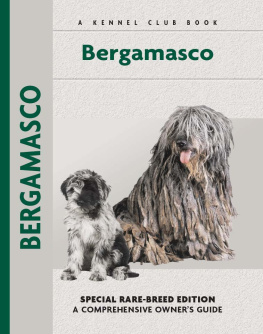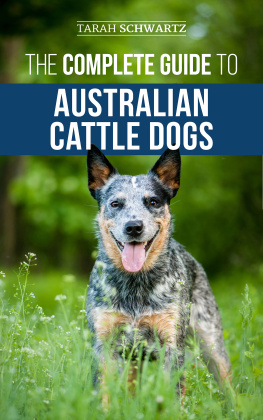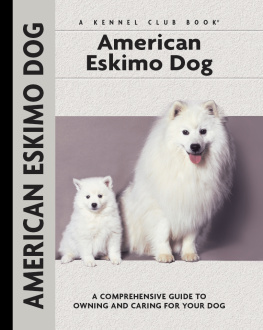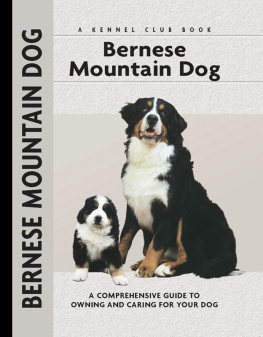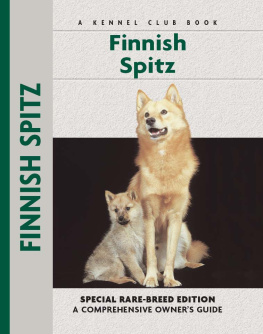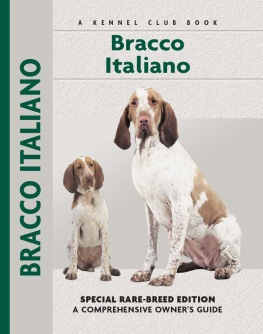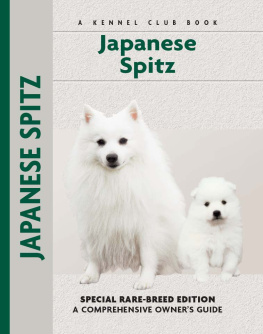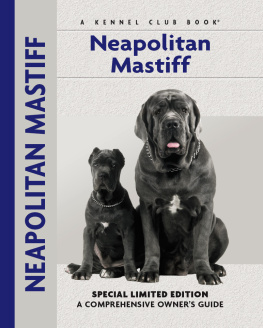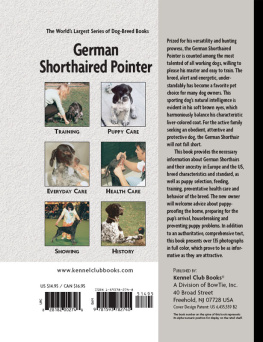Physical Characteristics of the Bergamasco
(from the Fdration Cynologique Internationales breed standard)
Head and Skull: Broad and slightly domed between the ears and rounded at the forehead. The skull is about as wide as it is long, and features a prominent occiput and a marked median furrow.
Eyes: Large, oval, and set just slightly obliquely. Eye color is brown, with the darkness of the color varying with the color of the coat.
Ears: Set high, semi-drooping, i.e., the last two-thirds of the lobe are drooping. Triangular shape.

Nose: Large and black, with big, well-opened nostrils.
Neck: Upper profile is slightly convex. The neck is a little bit shorter than the head.
Muzzle: Blunt, tapering only slightly toward the nose. The lips are tight and of black pigment.
Forequarters: Seen from front as in profile, limbs are straight. Height from ground to elbow is 50% the height at the withers.
Size and Weight:SizeThe ideal height at the withers for males is 60 cm (23.5 in) with a tolerance of 2 cm either above or below (1 in). For the females 56 cm (22 in), also with a tolerance of 2 cm more or less. WeightMales 3238 kg (7084 lb). Females 2632 kg (5771 lb).
Body: The Bergamasco is very slightly longer than tall.
Tail: Set on last third of rump, thick and strong at its root, tapering towards its extremity. Covered with goat-like hair.
Hindquarters: Limbs straight, as much in profile as from behind.
Coat: Texture typical of this breed is the presence of three types of hair: the undercoat, fine, dense and oily, adhering to the skin and forming a waterproof, protective layer; the goat hair, strong and rough as in goats and which stays smooth without tufting; and the woolly coat, finer in texture which grows together in flocks. The flock should be larger at its base, flat, irregular and sometimes opening fan-wise.
Feet: Front feet are oval shaped with well closed and arched toes. Rear feet are the same as the front ones except slightly smaller.
Color: The coat color is gray of all possible shades, from a most delicate gray to black.
CONTENTS

Trace the development of Bergamasco from its early days as a herder of migratory livestock to its spread from Italy to the rest of Europe, and finally to its place in America and Britain.

Meet a most intelligent herding breed, the Bergamasco, prized for its peaceable temperament, bravery, dignity and desire to question. Find out if this remarkable pure-bred dog is the right choice for you and your lifestyle.

Learn the requirements of a well-bred Bergamasco by studying the description of the breed as set forth in the Fdration Cynologique Internationale (FCI) breed standard. Both show dogs and pets must possess key characteristics as outlined in the breed standard.
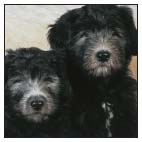
Be advised about choosing a reputable breeder and selecting a healthy, typical puppy. Understand the responsibilities of ownership, including home preparation, acclimatization, the vet and prevention of common puppy problems.
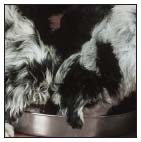
Enter into a sensible discussion of dietary and feeding considerations, exercise, grooming, traveling and identification of your dog. This chapter discusses Bergamasco care for all stages of development.

By Charlotte Schwartz
Be informed about the importance of training your Bergamasco from the basics of house-training and understanding the development of a young dog to executing obedience commands (sit, stay, down, etc.).

Discover how to select a qualified veterinarian and care for your dog at all stages of life. Topics include vaccination scheduling, skin problems, dealing with external and internal parasites and common medical and behavioral conditions.

Consider the care of your senior Bergamasco, including the proper diet for a senior. Recognize the signs of an aging dog, both behavioral and medical; implement a senior-care program with your veterinarian and become comfortable with making the final decisions and arrangements for your senior Bergamasco.
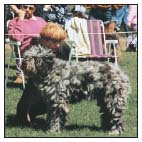
Experience the dog show world, including different types of shows and the making of a champion. Go beyond the conformation ring to obedience, herding and other competitive trials. Learn about the FCI, the world kennel club.
K ENNEL C LUB B OOKS B ERGAMASCO
ISBN 13: 978-1-59378-315-0
eISBN 13: 978-1-62187-062-3
Copyright 2004 Kennel Club Book A Division of I-5 Publishing, LLC
3 Burroughs, Irvine, CA 92618 USA
Cover Design Patented: US 6,435,559 B2 Printed in South Korea
All rights reserved. No part of this book may be reproduced in any form, by photostat, scanner, microfilm, xerography or any other means, or incorporated into any information retrieval system, electronic or mechanical, without the written permission of the copyright owner.
P HOTOGRAPHS BY I SABELLE F RANAIS AND C AROL A NN J OHNSON
with additional photos by Norvia Behling, T.J. Calhoun, David Dalton,
Doskocil, RBP, Bill Jonas, Mikki Pet Products and Alice van Kempen.
I LLUSTRATIONS BY P ATRICIA P ETERS.
The publisher wishes to thank the authors
and all of the other owners of the dogs featured in this book.

At the end of the 19th century, the Bergamasco was still referred to as the Alpine Sheepdog and the Northern Italian Sheepdog. The breeds official name is a fairly recent designation.

ORIGIN OF THE BREED
It is now universally accepted that the first centers for domestication of sheep and goats were located in central and southern Asia. From these regions, populations that migrated in search of new pastures from east to west settled in mountainous zones along a practically uninterrupted line from the upper plains of Asia across the mountains of Anatolia, the Caucasus, the Carpathians and the Alps to the Pyrenees.
Next page
